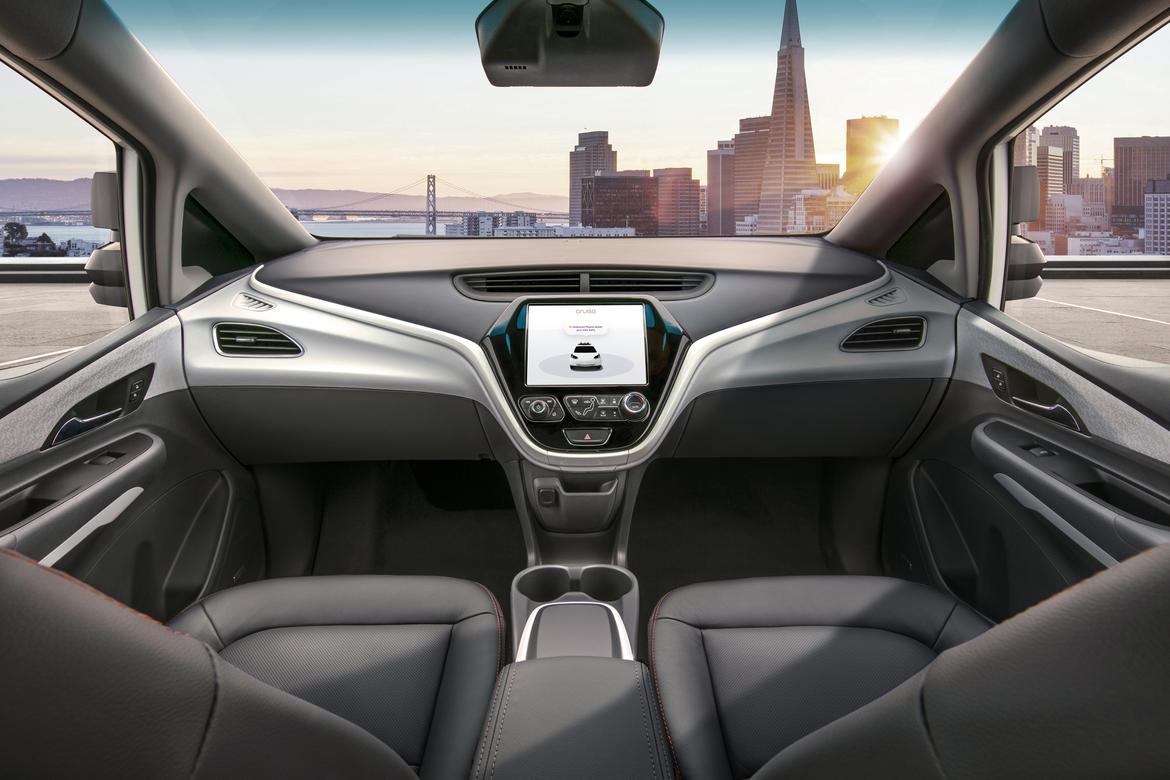
— GM has asked regulators for an exemption to existing safety rules so it can deploy self-driving cars without steering wheels or pedals. The automaker announced today that it filed a petition with the U.S. Department of Transportation to "safely deploy" a self-driving car — its Cruise AV — in 2019.
Related: 2019 Audi A8 Has High Self-Driving Capability — Are We Ready?
It's a bold move from GM, the automaker behind Buick, Cadillac, Chevrolet and GMC. But it's been in the making for at least 18 months, given GM acquired self-driving tech firm Cruise Automation in mid-2016. The Detroit automaker intends the aptly named Cruise AV to perform ride-hailing services in limited areas. It's the fourth generation of GM's self-driving car.
The all-electric runabout looks like a retrofitted Chevrolet Bolt EV — unsurprising, given the new Bolt EV serves as GM's self-driving platform — with a symmetrical dashboard that swaps the steering wheel and instrument panel for a mirrored layout of the passenger-side dash. As is common for self-driving prototypes, the Cruise AV employs dozens of sensors, with five lidar, 16 camera and 21 radar sensors in total.
In a 33-page report on the effort, GM noted extensive development of the car in San Francisco and Phoenix, promising it had "evaluated potential failure modes for all systems" and addressed them to ensure safety and reliability. That enables the automaker to "safely take the next step — elimination of the steering wheel, pedals and other manual controls."
That gets thorny. GM says it's complied with the government's latest automated driving guidelines, but the legalities of control-free cars are complex. Every new car sold in the U.S. must comply with a host of Federal Motor Vehicle Safety Standards, which mandate standards for everything from electronic stability systems to passenger impact protection. Among the standards are rules for rearview mirrors, accelerator pedals and more — features missing in GM's control-free car.
"Where FMVSS cannot be met because they are human-driver-based requirements, the vehicle will meet the safety purposes of those standards," GM's report said.
The automaker added that it will work with regulators to develop new safety standards and petition for "permission to meet the safety purpose of a standard through alternative means."
Asked for comment, two DOT spokespeople did not immediately respond.
Amid regulatory hurdles and technology validation, fully autonomous cars remain limited to fleet usage in small pilot programs. Most have driver controls and technicians behind the wheel if an override is necessary. Some — like the cars from Waymo, the self-driving division of Google parent Alphabet Inc. — are moving to driverless variants. But Waymo's self-driving fleet still has controls. Google debuted an autonomous runabout without them in 2014, but it limited the car to low speeds around its test facilities. When the car took to limited public roads a year later, the company added controls and a backup driver.
GM envisions a "controlled deployment," where the Cruise AV takes on ride-hailing duties only in geofenced areas with roads that have high-definition map data. Riders will request rides through a mobile app, then set the climate and radio stations before it arrives. Touchscreens inside will give real-time ride status and remind them to buckle up and close the doors, and the Cruise AV will have emergency buttons to communicate with support personnel or end the ride.
's Editorial department is your source for automotive news and reviews. In line with 's long-standing ethics policy, editors and reviewers don't accept gifts or free trips from automakers. The Editorial department is independent of 's advertising, sales and sponsored content departments.


